Canada 1994 "Prehistoric Life in Canada IV, The Age of Mammals"
| <prev | back to index | next> |
| Issue Date | 26.09.1994 |
| ID | Michel: 1448-1451, Scott: 1531-1534, Stanley Gibbons: 1615-1619, Yvert et Tellier: 1386-1389 Category: pR |
| Design | Design: Rolf P. Harder, Bernie Reilander |
| Stamps in set | 4 |
| Value |
43 - Arctodus simus, short-faced Bear from Pleistocene Epoch 43 - Megacerops from Oligocene Epoch 43 - Coryphodon from Eocene Epoch 43 - Mammuthus primigenius, woolly Mammoth from Pleistocene Epoch |
| Emission/Type | commemorative |
| Places of issue | Edmonton, Alberta |
| Size (width x height) | 45mm x 33mm |
| Layout | Sheet of 20 |
| Products | FDC x1 |
| Paper | Low Fluorescent Peterborough paper (PP) with fluorescent frame (GT4), no Watermark |
| Perforation | 13.5 x 13.5 |
| Print Technique | Offset lithography |
| Printed by | Canadian Bank Note Company, Limited |
| Quantity | 4 250 000 each |
| Issuing Authority | Canadian Post |
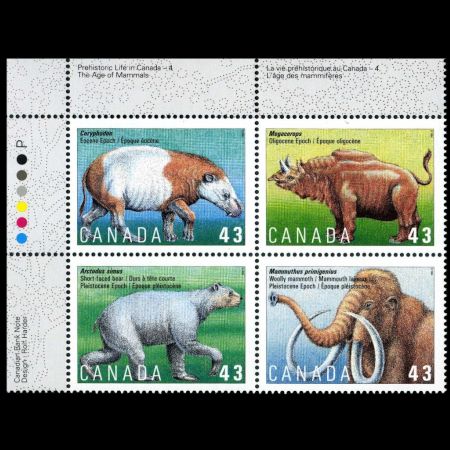
On September 26th 1994, Canadian Post issued the set "Prehistoric Life in Canada IV, The Age of Mammals" - the last of four stamps in a four-year series on "Prehistoric Life in Canada". The series is chronological and covers an interval of time from 1900 million to 10,000 years ago. The 1994 set was denominated at 43 cents per stamp.
Mammals appeared about 190 million years ago, and became dominant after extinction of dinosaurs some 65 million years ago. Mammals are warm-blooded, hairy animals with backbones, possessing four-chambered hearts and diaphragms to help breathing. Most give birth rather than laying eggs, and all feed their young from milk-producing mammary glands unique to the class Mammalia.
The four depicting here are long since extinct.
-
Arctodus simus, the short-faced bear, sometimes called the "bulldog bear", was the largest land carnivore in North America
during the ice age.
Unusually tall, it reached nearly 1.5 metres at the shoulder when walking and 3.4 metres when up
on its hind legs.
Taller than a brown bear, the short-faced bear was not as heavily built, with limbs, particularly the
hind legs, which were longer and slenderer.
With a relatively short face lacking in a well-marked forehead, it had a short, broad muzzle resembling
a lion rather than any living North American bear.
The short-faced bear became widespread in western North America about 1 million years ago, occupying higher, well-drained grasslands west of the Mississippi River. Its northern range reached the Yukon and Alaska, indicated by a leg bone and partial skull from frozen silt found near Dawson City, Yukon dating almost 30,000 years ago. Other recorded Canadian specimens are from Old Crow Basin and Sixtymile in the Yukon, Edmonton Alberta and Saskatchewan. The short-faced bear died out toward the close of the last glaciation, partly because of the earlier extinction of some of its large herbivorous prey, and partly due to increased competition with brown bears, which entered North America some 200,000 to 130,000 years ago during the Illinoian glaciation.
Tremarctos ornatus, the spectacled bear of South America, is the closest living relative of this extinct mammal. - Mammuthus primigenius, the woolly mammoth probably originated in north-central Eurasia, spreading westward to England and Spain and eastward via the Bering isthmus to the tundra-like regions of North America from Alaska to the Atlantic Coastal Shelf. A great deal is known about its appearance due to the discovery of several well-preserved carcasses in frozen ground in Siberia and from the study of many detailed carvings, engravings and murals by Stone Age (Paleolithic) artists. Often used as a symbol of the ice age, the woolly mammoth reached the size of Asiatic elephants to which it is closely related. Derived from steppe mammoths, woolly mammoths were first recorded in deposits of the second last glaciation 150,000 years ago in Eurasia. As time progressed its physical characteristics changed in order for it to survive under increasingly cold conditions. In Canada it is known to have existed in all areas except Quebec, Prince Edward Island, New Brunswick, Nova Scotia and Newfoundland. One of Canada's best specimens is a skeleton of an adult female from Whitestone River YK, that is about 30,000 years old.
- A large tapir-like, short-legged mammal weighing about 500 kilograms, Coryphodon was about one metre at the shoulder and 2.3 meters long. Although it had a large skull with canine tusks like those of a hippopotamus, its brain at 90 grams was very small - one of the smallest brain/body weight ratios known among mammals. A browsing animal, Coryphodon probably had semi-aquatic habits like today's hippo, feeding on roots, tubers and aquatic plants. Widespread in North America between 59 and 51 million years ago, this large mammal ranged from Ellesmere Island in the north to Mississippi, Texas and New Mexico in the south. Both plant and vertebrate fossils from Ellesmere Island, Canada's most northerly island, indicate that Coryphodon lived there in a warm temperate climate along with small alligators, soft-shelled turtles and horse-like mammals.
- Megacerops, one of about 40 members of the family Brontotheriidae, was the largest land mammal of its time. Somewhat rhino-like in appearance with a large horned face, it stood 2 metres tall at the shoulder, was 3.2 metres long and may have weighed nearly 4 tonnes. Megacerops is distinguished by its long cylindrical horns that extend upward in a "Y"-shape from the nasal bones. The forehead is long and saddle shaped, with eyes set well forward. The body is massive and the limbs robust - adapted to carry a considerable bulk. It was probably a browser, feeding on trees and shrubs of the woodland. Common in western North America, it lived near what is now Eastend SK about 37 million years ago in a parkland type of environment along with giant pigs and small deer-like grazers.
Products and associated philatelic items
| FDC | Example of circulated covers | |
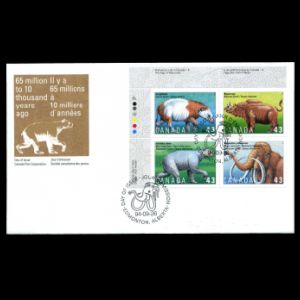 |
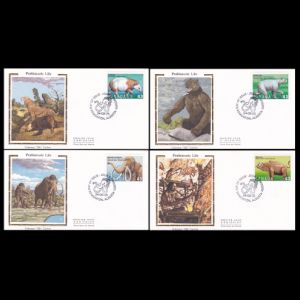 |
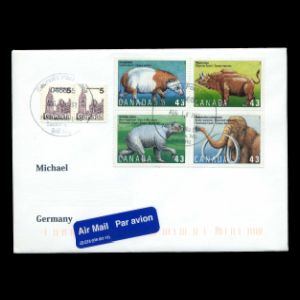 |
| The reverse side is here | Personalized FDC set | |
| First-Day-of-Issue Postmark | Stamps Sheet | Souvenir folder |
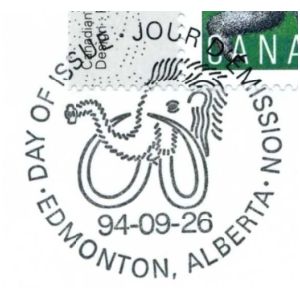 |
 |
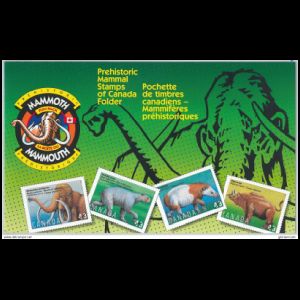 |
References

|
- Technical details and description of the stamps:
The Postage Stamp Press Release of Canada Post Corporation, reverse side of an FDC, colnect. - Arctodus simus (short-faced Bear): Wikipedia
- Coryphodon: Wikipedia
- Mammuthus primigenius (Woolly Mammoth): Wikipedia
- Megacerops: Wikipedia
- Eocene Epoch : Wikipedia
- Pleistocene Epoch : Wikipedia
- Oligocene Epoch : Wikipedia
Acknowledgements
Many thanks to Dr. Peter Voice, PhD Department of Geological and Environmental Sciences, Western Michigan University, USA, for his help in finding information and for review of a draft of this article.| <prev | back to index | next> |